SMS Marketing General: The In-depth Guide for Your Business
Quick question: Where is your mobile phone?
Well, we’d bet it’s nearby, at least within eyeshot.
Mobile phones have inundated every aspect of our society. Nowadays, teenagers are receiving mobile phones earlier than their older counterparts - most at age 12. For those currently 18 to 24, the average age to receive a phone was 16. For those between ages 25 and 34, the average was 20.
In a world riddled with distractions and disruption, our phones are one of the few channels that can snag and keep our attention. We love our phones, and businesses know it. And phones become one of the best channels for reaching your customers with relevant, personalized messages.
However, you cannot just put thousands of contact numbers into your phone, send mass messages, and hope for the best. You need proven SMS marketing strategies, stellar ideas, and tried-and-tested practices that actually engage your contacts.
That’s exactly what this guide from AVADA Commerce will provide you. Let’s explore!
Firstly, what is SMS Marketing?
SMS (Short Message Service) marketing is the practice of marketing your products/services through permission-based text messages that consumers receive on their mobile devices.
Generally, text messages are 160 characters or less and may include a number of multimedia elements, such as images, videos, GIFs, and links. Senders must abide by their country’s regulations and rules, as well as those of the recipient.

The process of SMS marketing is similar to subscribing to an email list. When someone texts an organization’s 5-digit shortcode, their phone numbers are stored in the SMS marketing software used by the organization to issue messages.
The goal of SMS marketing is three-fold:
-
To build a database of engaged, active customers who are easily identifiable as they have to intentionally opt-in to your marketing messages.
-
To send updates, reminders, and discounts that convert, retain, and re-engage customers.
-
To reach customers with marketing messages that have little to no interruption or require push notification apps, such as social media or email.
Many local businesses worry that SMS marketing software is too complicated to implement or promotions can frustrate customers and damage their relationships. However, with the right information and practices, SMS marketing can be a huge asset and revenue driver.
Implemented correctly, SMS marketing can strengthen relationships by inviting responses. With relevant content and well-timed messages, it feels much more intimate than other marketing messages and motivates continued engagement in a way only text can. The key here is knowing how to message the right way.
The history of SMS marketing
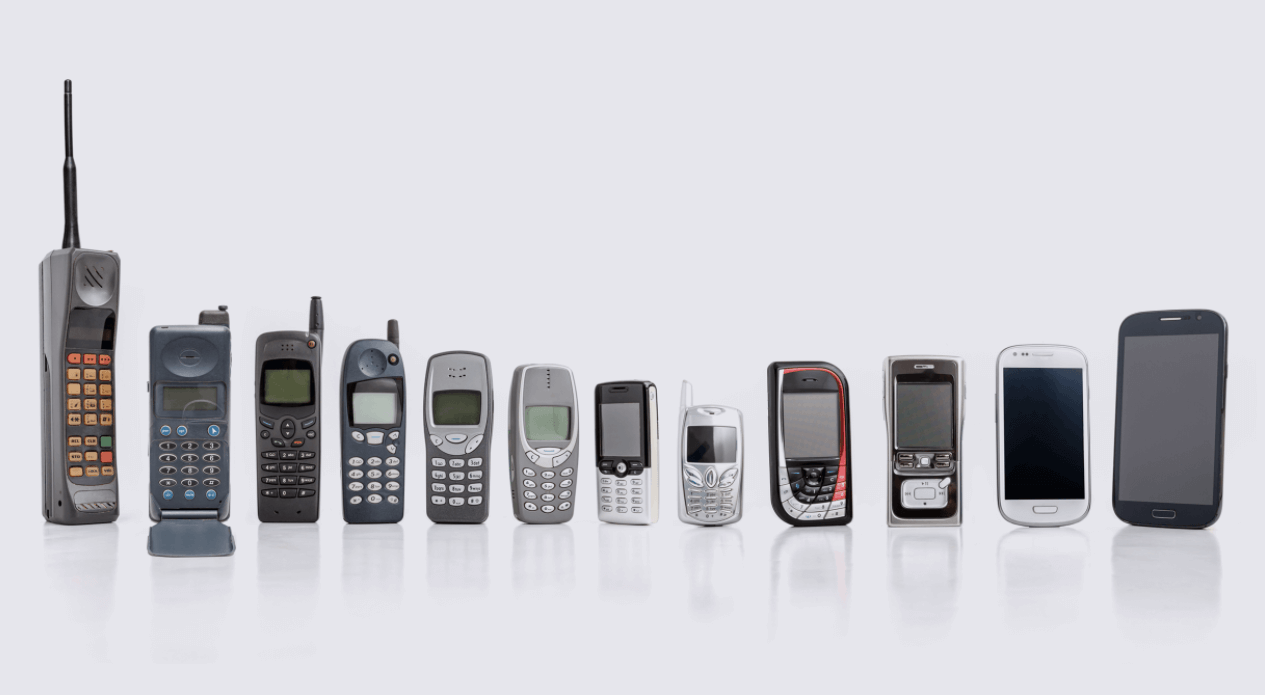
SMS marketing comes from humble beginnings.
What drove text campaigns to the top of the marketing food chain was the advent of smartphones. Marketers quickly realized the power of reaching people on these new devices and took action. However, a lot led up to that big moment in SMS marketing.
-
GSM Corporation developed the technology of powering the modern text message in 1984.
-
8 years later, the first recorded text message was sent. In 1992, Neil Papworth sent a simple message to Vodafone’s Richard Jarvis.
-
In 1999, five- and six-digit shortcodes were invented.
-
By 2002, the volume of text messages sent around the world ramped up to more than 250 billion. Nike, Eurovision, Pontiac, and other large brands began to see the value in SMS marketing and launched huge text campaigns.
-
By 2003, shows like “American Idol” were using a text-to-vote feature of SMS marketing with an impressive 7.5 million text messages being sent. This marked a high note of SMS marketing.
-
In 2007, the number of SMS messages sent each day surpassed the number of voice calls. This is also the year that Apple released its first iPhone.
-
In 2010, the word “texting” was added to the Cambridge dictionary as a verb, which means to send a text message.
-
In 2011, Apple’s iMessage was introduced. This is an instant messaging service that exclusively works on Apple platforms, such as iOS, macOS, iPadOS, and watchOS.
-
In the subsequent years, many mobile phone users started using other instant messaging apps, like WhatsApp, Facebook Messenger, and iMessage, instead of regular texting apps. However, SMS messaging is still the most widely used device feature, with around 5 billion people sending and receiving SMS messages, and over 200,000 SMS texts sent every second.
SMS marketing benefits

Below are 9 benefits of SMS marketing that will help strengthen your business.
-
Instant delivery. An SMS to a single recipient is often delivered within seconds. For a larger group, it’s within minutes. For example, if a business campaign is planned for 20,000 customers, it’ll take about 16 minutes to deliver all the messages from the scheduled start time. Incredible, isn’t it?
-
Better customer engagement. Texting not only provides you an avenue to connect with your customers, but also allows your customers a way to engage with you. It lets them reach you at any time while making your business become a part of their personal lives.
-
Reliable. Another benefit of SMS marketing is that, unlike email, there is only one inbox. With text marketing, if you have the recipient’s number, they are going to get your message. Nevertheless, on email, you can land in the Promotions tab, or worse, the feared Spam box. If 0.2% of subscribers mark your emails as spam, you could end up in spam for your whole contact list. SMS doesn’t have this issue: even if someone blocks your number, it isn’t going to affect other text messages that you sent out or how your campaign performs.
-
High open rates. Studies show that SMS marketing has an extensively higher open rate at 98% when compared to just 20% for emails. Plus, it takes around 90 seconds for someone to reply to a text vs. 90 minutes to respond to an email. As a matter of fact, 75% of customers would like to receive more texts from businesses.
-
Cost-effective. SMS marketing is much more affordable than other marketing channels, such as Facebook and Google ads. Also, on these costly platforms, your message can get lost in the plethora of other posts that are competing for your audience’s attention.
-
Quick opt-in and opt-out options. It’s essential to give your recipients an option to receive or not to receive your messages. Long-code and short-code numbers can provide recipients the option to opt-in or opt-out of messages. Businesses can configure simple keywords for recipients to respond quickly. This simplicity helps keep your subscriber satisfaction high.
-
Better support and integration with other channels. It’s vital that all channels work well together within your marketing mix and SMS marketing is no exception. SMS marketing is an excellent standalone channel, but it also has the ability to enhance and support other channels, such as social media and email. For instance, it can remind customers to read an email sent hours or even days before. A simple follow-up text message asking “Have you read our email?” can help increase your email open rates by 20%-30%.
-
Able to monitor, track, and improve. It’s possible to identify customer engagement, monitor delivery rates, and track meaningful ROI via SMS marketing. By using analytics, businesses can create further targeted campaigns and continually establish a better understanding of their mobile database.
-
Limitless market potential. Do you know how many mobile phones are out there? An absolutely huge amount. And because mobile phones and text messaging are the way people communicate now, there is no reason you can’t penetrate into this virtually limitless market potential. Mobile phone users actually represent all demographics - a marketing gold mine!
Some SMS marketing statistics
As you can see, SMS marketing has a lot of potentials.
However, doing it is one thing, and doing it right is another thing.
If you want remarkable results, you should keep in mind the SMS marketing statistics shared in this guide.
So, let’s explore!
Average open rate for SMS marketing
SMS marketing’s average open rate is between 98%-99%.
However, open rates for text messages are widely discounted as a vanity metric for several reasons:
- Open rates for SMS messages are hard to track
- SMS messages are almost always opened by the end-user, giving us a 99% open rate. That is a compelling number, but not where your key focus should lie.
If you are comparing the open rate of email marketing versus that of SMS marketing, SMS will come out on top (by far). However, it is better to focus on a more conversion-driven metric like CTR or EPM.
Average response rate for SMS marketing
The average response rate for text marketing is 45%, while that for email marketing is 6%.
In fact, when offers and promos are sent via text, they are much likely to be opened, responded to, and lead to sales. However, you should be aware that a lot of marketing emails are not even intended to be responded to. They are just used as a megaphone, not a conversation.
Average CTR for SMS marketing
What is the average CTR (click-through rate) for SMS marketing?
Actually, it depends!
It depends on the type of your business, what offers you are sending, how often you are sending, etc.
According to the Signal Report, the average CTR for SMS marketing was 6.16%. The data was taken from 20 different text marketing campaigns, ranging in size from 5,000 to 2.5 million SMS subscribers.
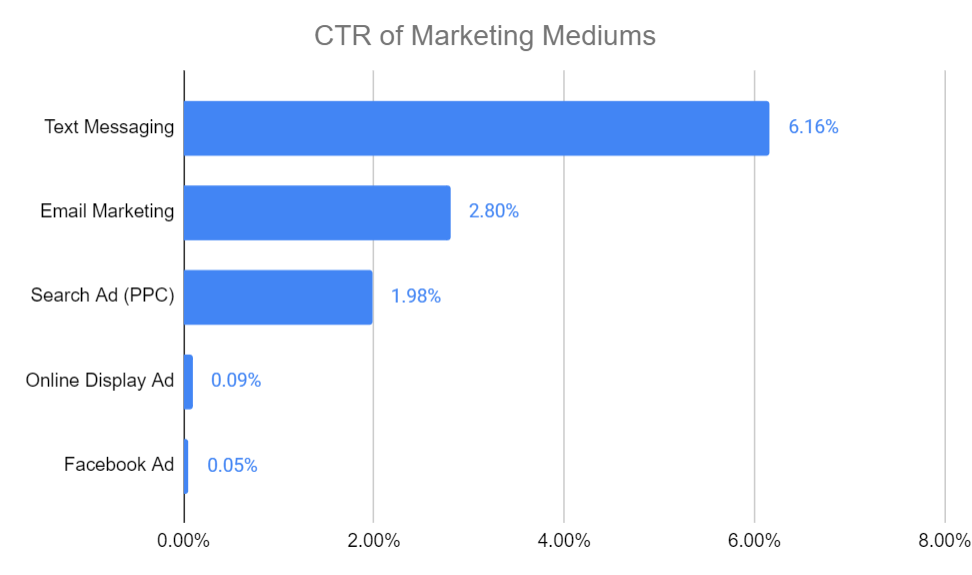
Another study comes from Dynmark. In their report, they analyzed almost one billion SMS transactions through 1,500 networks ranging 42 mobile operating systems along with a multitude of countries. They claimed that the average CTR for SMS marketing was 4%, with retail averaging 8% and entertainment averaging 14%.
They also found that on average, 43% of clicks occurred within the first 15 minutes. This doesn’t seem unrealistic, as we know that up to 90% of text messages are read within 3 minutes, and almost all SMSes are read within the first 20 minutes.
Below is a breakdown of each industry, along with the percentage of clicks that happened within the first 15 minutes.
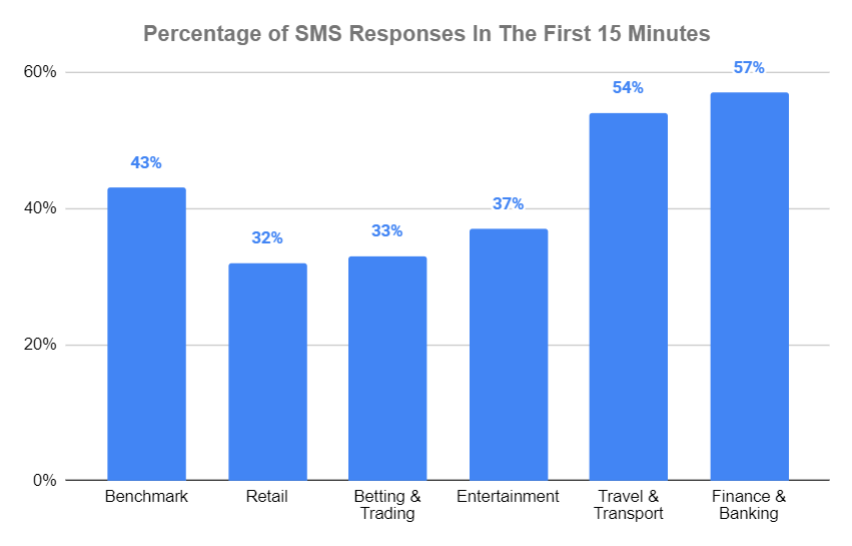
Again, we think it depends. We know it is possible to get as high as 30% CTR, but we would say the average CTR for SMS marketing is somewhere in the 5-10% range.
Average EPM for SMS marketing
SMS marketing’s average EPM (Earnings Per Message) depends on your product’s price, your message’s intent, and the volume of texts sent out.
Studies found that the mean EPM varies from $0.69 to $8.11. In short, the more a recipient has engaged with your business, the more likely they are to purchase. That’s why campaigns like abandoned carts create a higher amount of business.
Average SMS unsubscribe rate
The average SMS unsubscribe rate varies between 0.9% and 3.1%, again depending on the message type being sent.
Welcome series have the highest SMS unsubscribe rate, perhaps because customers are not exactly sure of what they sign up for when they opt-in to SMS marketing. Therefore, ensure that you explain this in your initial communication, such as the collection pop-up, solves for this and keeps your business compliant.
As for the lowest SMS unsubscribe rate, campaigns see the lowest number of people opting-out. This makes sense, as campaigns are often sent to customers who are already familiar with your brand name and who have been subscribed to your list for a while.
Let’s talk about unsubscribe rates for a second - for many marketers, the mere thought of recipients unsubscribing sends shivers down their backs.
But actually, unsubscribing is a good thing. It keeps your marketing lists hygienic and makes sure that you are only sending messages to people who are really interested in your products. That also keeps your marketing spend low and other metrics (like engagement and EPM) high.
Average SMS volume
The average brand delivers 1 SMS message per week.
Studies from Postscript found that stores sent 5-6 messages in the subscriber’s first month, and then 3-4 messages each month in the months thereafter.
Actually, if you don’t have a special use case (like daily product drops, or a very high repeat purchase rate), you are likely to find success with 2-6 texts per month, with 4 being the most common.
Of course, this also changes for text messages that are purely transactional, delivery-based, or notification-based. For instance, Lunchdrop - a meal delivery service - sends a text every weekday, because they are asking you to choose your meal. No follow up needed.
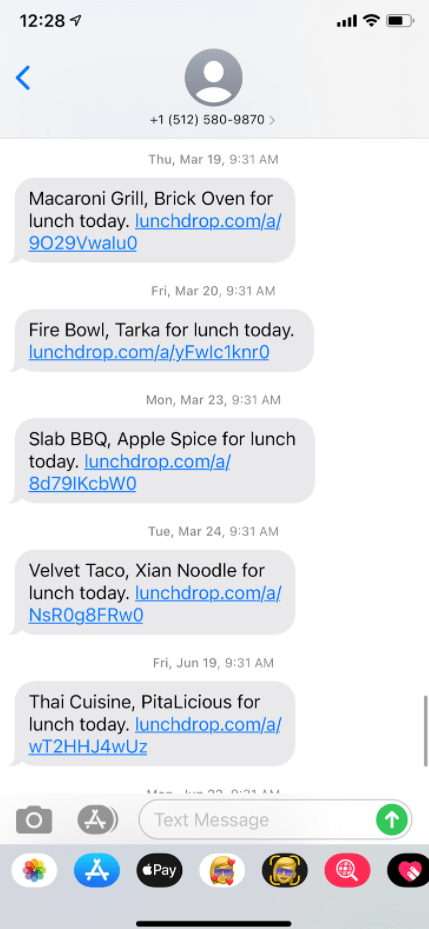
Types of SMS Marketing campaigns
In fact, not all SMS marketing messages are created equal. Depending on who you are texting and what you are asking them to do, the type of SMS marketing will vary.
There is more to SMS marketing than simply sending messages. Let’s go through some types of SMS marketing as categorized by two strategies below.
1. On-demand SMS
The first SMS marketing type is on-demand SMS. These are universal text messages sent to segments of your audience based on your marketing or promotional schedule, such as general discounts, company news, and alerts, or holiday promotions. On-demand SMS marketing is not based on subscriber activity.
1.1. Discounts and promotions
Discounts, sales, and promotions can engage your audience with urgency. They often offer a dollar amount or percentage off full-price products/services or a promotional deal like “Buy One, Get One Free.” These messages should always be time-sensitive and include a powerful CTA (call to action) that encourages recipients to visit your website.

1.2. News and alerts
News and alerts keep your recipients up-to-date with company and product information. These messages could notify recipients about store hours, new product arrivals, simple holiday greetings, or special events. You can also offer subscribers more details if they respond to your message.

1.3. Competitions and contests
Generally, competitions, contests, and text-to-win campaigns are common ways to engage both new and existing subscribers. To enter, customers must text your short-code with the required entry information, like a photo of them using your products.
In these text messages, ensure to include whether or not you will be adding those who entered into your subscriber list.

2. Behavioral SMS
The second SMS marketing type is behavioral SMS. There are triggered text messages sent based on subscriber activity, such as abandoning a shopping cart, making a reservation, or requesting customer service. (FYI: On-demand SMS is to bulk email, while behavioral SMS is to triggered email.)
2.1. Personalized discounts
Personalized discounts, sales, and promotions are tailored to each recipient, either in the timing and/or the discount code. They are often sent following subscribers’ recent browsing or activities to re-engage them. These messages are effective because recipients feel as if they are receiving a unique discount opportunity, such as a private, special sale.
With this type, you can send in-store or online coupon codes directly to recipients. Pick your codes thoroughly so that you don’t run into people who are stealing or sharing codes to get deals. This allows for better tracking and protects your bottom line.
You should make it easy to use the code. Consider allowing recipients to add your codes to digital wallets or simply show the text in the physical store.

2.2. Reminders
Reminders are useful for subscriptions, reservations, appointments, and special events. These messages are sent based on subscriber activity on your website, such as buying a ticket or making a reservation. They are also effective to send when recipients are at similar events or nearby your store to remind them to consider an additional, relevant purchase.
Subscribers rely on text reminders, so make sure that your messages are time-sensitive and sent with enough notice to change or cancel any appointments or reservations if necessary. These can help you cut down on last-minute cancellations and no-shows.
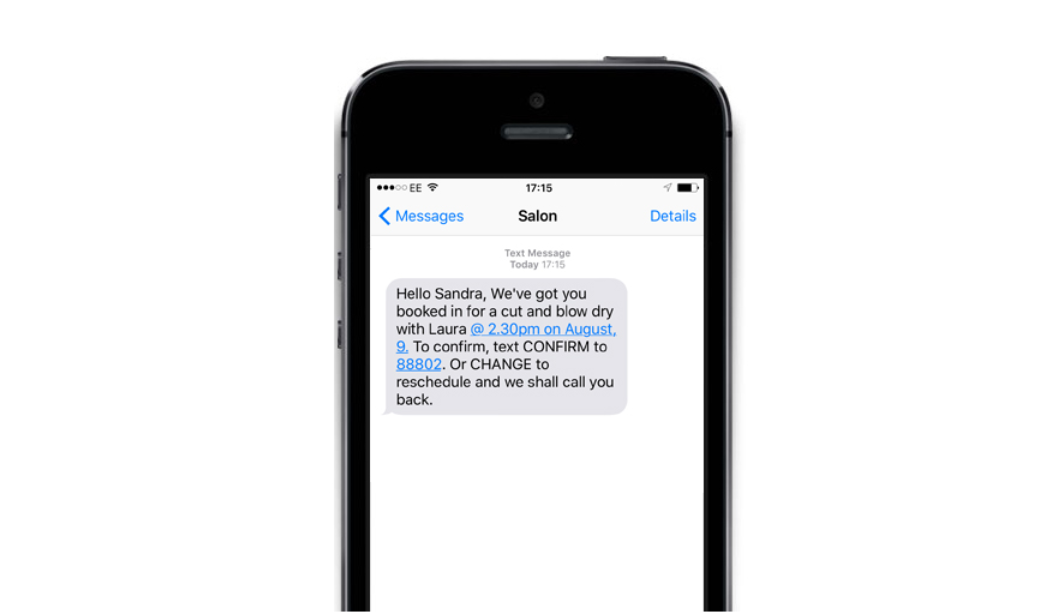
2.3. Product or loyalty program updates
Some updates are only relevant to specific customers, like back-in-stock updates of particular products or loyalty program updates with new rewards or points.
These messages can make recipients feel special and valued, especially when they are being delivered right on their phones. Send these types of updates following behavior like purchases or restocking products on customers’ wish lists.
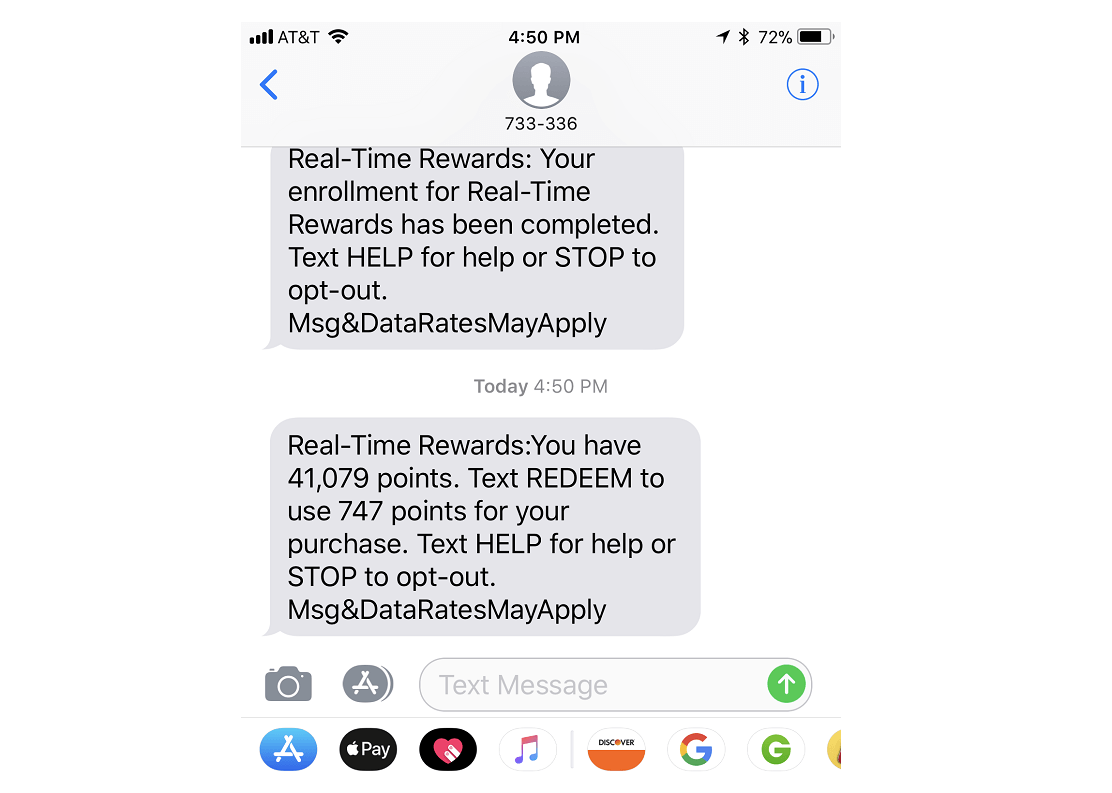
How does SMS marketing work?
You can break down the basics of text marketing into three simple steps:
-
You send mass texts to potential customers, including a keyword, code, and disclaimer.
-
Those who are interested in getting texts from your brand respond to the text with the keyword you sent. That’s called opting-in, and it means you have permission to send that person text messages.
-
Your platform sends an automatic response to those who subscribe. This response includes a code that lets them opt out (unsubscribe) at any time.
You can send messages to and receive them from people who have opted-in. That means you can send news, reminders, updates, and many more.
Grow your SMS opt-in list
The majority of local companies find maximizing their SMS list to be the most challenging step of SMS marketing.
Why?
Many organizations are forgetting to collect phone numbers and explicit consent, or failing to maximize their opportunities to collect opt-ins.
However, be aware that local businesses have an unfair advantage. Customers are 21% more likely to opt-in to text promotions of local businesses over the major chain or big-box retailers. They are also 45% more likely to opt-in over online or E-commerce businesses.

So, how can you turn interactions into opt-ins? The answer is to integrate opt-in entry points at every possible step of your customer journey.
There are a lot of touchpoints along your customer journey where gathering an opt-in is natural and even expected. If you can take advantage of them, the list will build itself.
1. Website touchpoints
Your website is usually the first touchpoint to capture a prospect’s attention. It is also a great way to collect opt-ins from those who haven’t transacted yet and can serve as a mechanism to convert leads into consumers.
1.1. Online sign-up pages and forms
This involves creating landing pages that are dedicated to collecting opt-ins. With this touchpoint, location-specific pages can be created and shared via URL or QR code.
Keep in mind that not all sign-up pages are created equal. Effective landing pages offer fields to collect visitors’ names and phone numbers, use straightforward legal language to communicate that they are collecting information for SMS marketing purposes, and should be customized in order to fit your brand.
1.2. Website banners, pop-ups, and prompts
With this type, visitors opt-in by filling out a banner pop-up that appears on your page after a specific time delay.
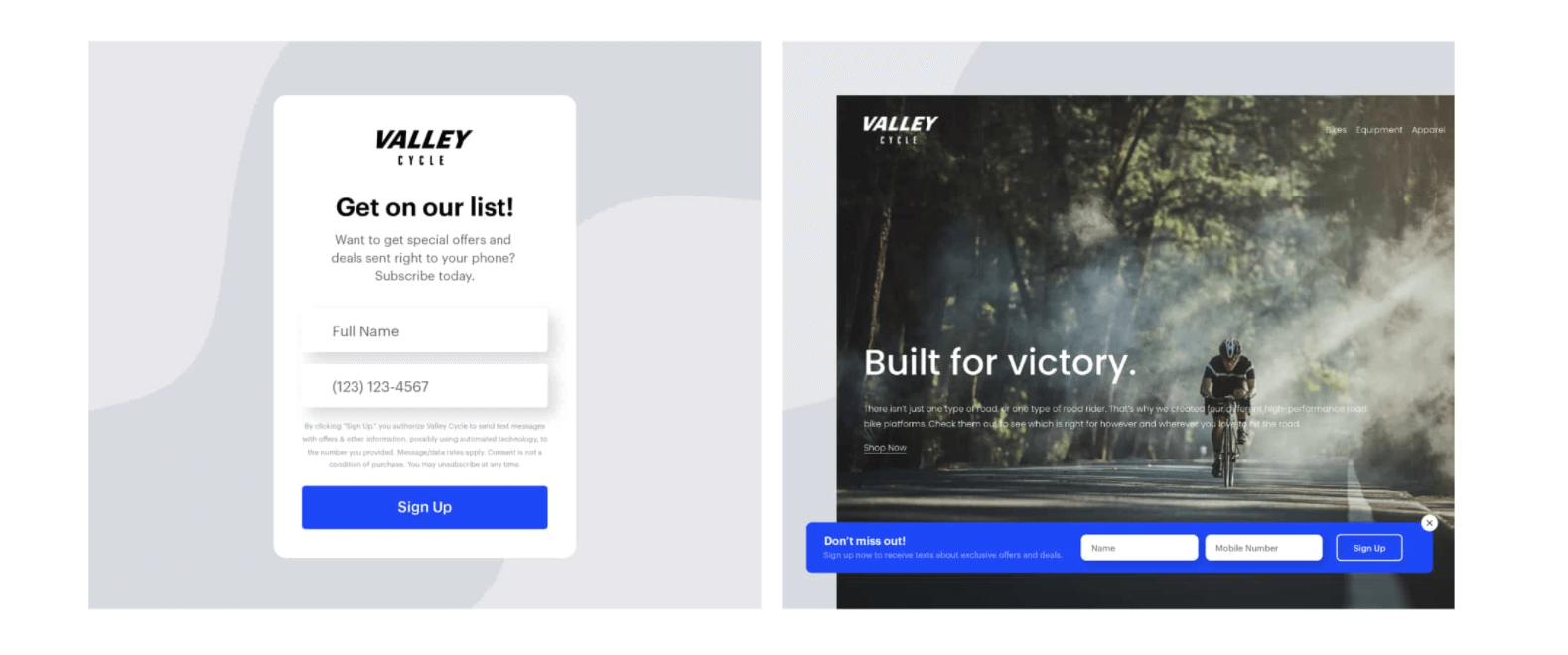
1.3. Website chat
Website chats are places where visitors can ask questions, set appointments, as well as check for availability. They are also opt-in wellsprings.
You can leverage your website chat to include an opt-in touchpoint whenever someone contacts you. This might involve using a “Contact us” form or an embedded lead form (with the proper legal consent).
1.4. Point of sale or transaction
Capturing opt-ins at the point of sale can work well if you make it easy, such as giving the option after customers transact through an SMS invoice. You might even integrate an opt-in point within a POS system or check-out cart that can collect it.

1.5. Review
This opt-in touchpoint closes the loop. People who leave positive reviews are more likely to want to receive future offers and promotions.
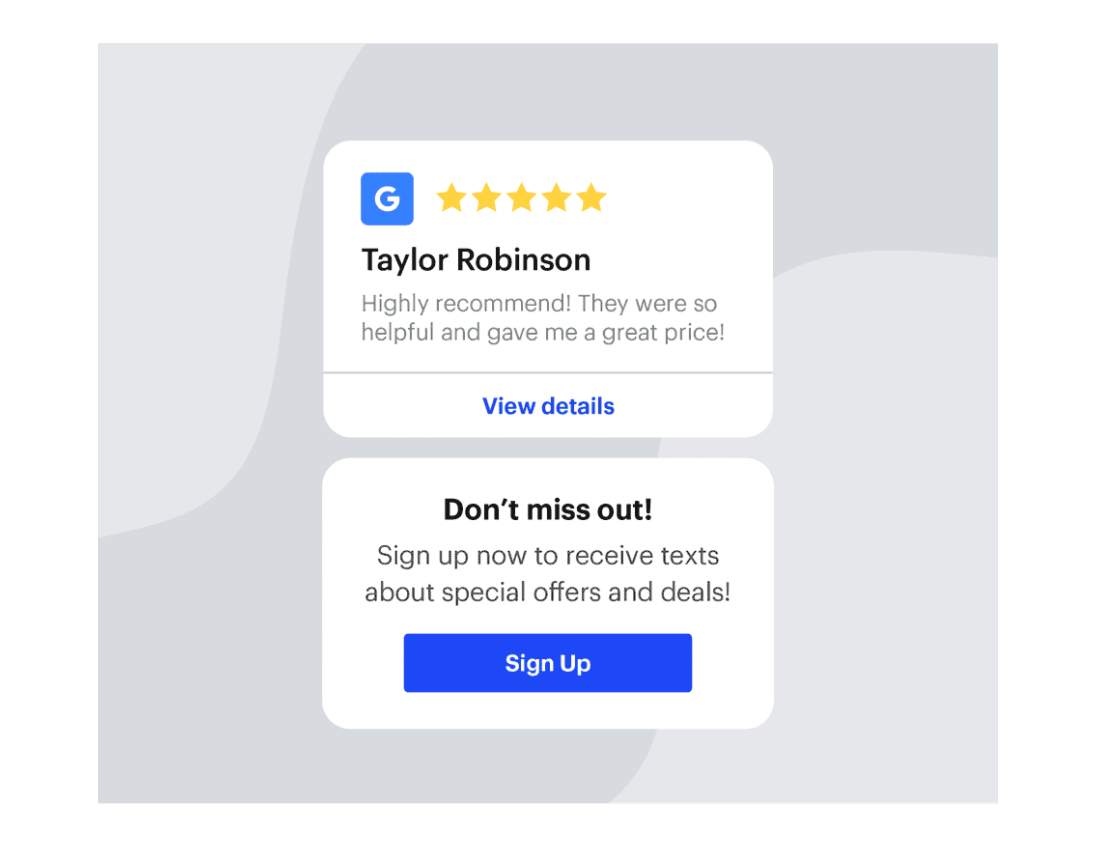
2. Hybrid touchpoints
Nowadays, businesses can operate online, in-store, or face-to-face - even some combination of all three.
With the right touchpoints, you can collect opt-ins wherever and however you operate. Below are several out-of-the-box ways you can display your sign-up forms to build your list.
2.1. URL & QR code
Once you have created an online sign-up form, you can share it via URL or QR code.
-
URL can link prospects and customers directly to your sign-up form. They are particularly useful for sharing over social media channels and converting an existing email marketing list.
-
QR codes help present your sign-up forms on printed (wall signs or table tents) as well as digital signage (TVs/monitors/tablets that are in-store). You can also display them via business cards, product packaging, stickers, cash register stands, or physical check-out locations. All customers need to do is scan your QR code with their smartphone camera and then get redirected to your opt-in sign-up form.
2.2. Sign-up/Opt-in station
An online sign-up form presented on a smartphone, tablet, computer, or laptop is a great way to gather opt-ins face-to-face. Many brands find it effective at trade shows, events, and pop-ups.

2.3. Text-to-join “keyword”
You can also establish a textable “keyword” to collect opt-ins from prospects and customers. This doesn’t rely on having an online sign-up page to be set up. However, it requires your business to offer a keyword like “Subscribe, “ “YES,” or “Y,” which can then be texted to your business’s number to opt-in. A textable keyword, much like a QR code, actually can be printed or displayed digitally alongside the appropriate consent language.
3. Existing channels
Don’t forget - if you can take advantage of your existing marketing channels to reach customers, you can collect more opt-ins by using the communication strategies that customers are already used to.
3.1. Email
Many businesses are already doing email marketing and building large email marketing lists. You can convert email marketing contacts into text marketing opt-ins by sending an email blast motivating people to opt-in to promotional texts. Generally, this is facilitated by a URL link to the online sign-up page, which can be included in the email copy or your signature.
Below are some templates that you can use immediately.
Template 1:
Hi {first_name},
At {company_name}, we always love providing amazing service. That’s why we are implementing a new feature to our system that enables us to send you messages to keep you up-to-date on new promotions and special offers right to your phone!
Don’t miss out! Click right here to opt-in to our text message promotions.
Sincerely,
{Your_name}
Template 2:
Hi {first_name}, thanks a lot for your continued business. Never miss another special promotion! Click right here to opt-in to exclusive text promotions and save 15% on your next purchase!
Related topic: 28+ SMS Templates for Marketing That You Can Apply Immediately
Some marketing platforms provide automation workflows that include both SMS and email marketing to maximize your revenue. AVADA Commerce can help you do that easily and effectively!

It is simple to create an automated workflow in AVADA Commerce. You just need to drag and drop elements and hit the “Send” button. The platform’s team support is always willing to help you solve all your queries and problems. Especially, with a free plan, you can start trying it right now!
GIVE AVADA COMMERCE A NICE TRY
3.2. Social media
Social media networks, such as Facebook and Instagram, are other efficient avenues to socialize an online sign-up form. You can create a social post with a QR code, URL, or keyword to capture opt-ins through those channels.
3.3. Mailers
Consider adding a QR code graphic or printed keyword to your mailers in order to engage even your most remote customers.
SMS marketing strategies
In the last section of this in-depth guide, we’ll compile some SMS marketing strategies to boost your next campaigns. Let’s explore!
1. Get permission
This is an SMS marketing non-negotiable. According to the TCPA (Telephone Consumer Protection Act), written consent is a requirement. If you text someone without their consent, your messages will be considered spam and you might face legal consequences.
In this case, written consent can be in the form of an opt-in text message or completing an online form. Both count in the eyes of the TCPA.
How can you have your audience intentionally opt-in? Consider the following strategies:
-
Advertise your SMS campaign as you would an email newsletter. Publish your short-code and ask subscribers to text a simple word like “JOIN” or “YES” to be added to your list.
-
Encourage your customers to sign up for an account or join your loyalty program, and ask for their phone number in the process. Remember to include that you’ll be sending marketing materials if they give you their phone number.
-
Ask for a phone number during in-store or online purchases. Include a disclaimer about your SMS campaign so that anyone who isn’t interested in joining can opt-out.
-
Include a simple and straightforward sign-up form on your website promoting your SMS campaign.
-
Offer special discounts or promotions only accessible via SMS.
Read more: SMS Marketing Laws/Rules: The Ultimate Guide
2. Send a clear confirmation text
The first message subscribers get from you is arguably the most vital. It is their first impression of your SMS marketing campaign and may dictate if they stick around or not.
Here is what to include in your confirmation text:
-
Your business or organization name. This tells recipients who is texting them.
-
The purpose of your SMS marketing campaign. This tells recipients exactly what to expect from your messages.
-
The frequency with which you will send text messages.
-
A notice about the text message and data rates (i.e., “msg & data rates may apply”). Unlimited texting has been increasingly common, but it’s still important to include for those subscribers who don’t use that.
-
Instructions for how to unsubscribe/opt-out of your SMS marketing list. For example, subscribers can text the word “STOP” to stop receiving your text messages.
-
Instructions for how to receive help from your customer support team. For instance, subscribers can text the word “HELP” to trigger a customer service sequence with a support phone number or email.
3. Keep your messages concise and personal
The typical length of a text marketing message is around 160 characters. In order to keep your audience engaged, avoid exceeding that limit. The brevity of text messages is what can set this marketing strategy apart from email marketing - and what makes it so successful. Plus, always personalize your messages with your organization’s name.
4. Get creative
Have you ever listened to a song so much that you get sick of it? The same can happen with your text messages. Keep everything interesting with a variety of offers.
Send a special discount one week, a useful tip the next, and a fun piece of content the following. Don’t be afraid to get creative. Here’s an example from Jurassic Quest, a travelling dinosaur exhibit. They not only send announcements, but also let people text in their dinosaur questions which are answered by an expert!

5. Speak to your persona(s)
As you would do with any other marketing material, consider your target audience when creating your SMS marketing copy. It may be tempting to save space in your text messages, but avoid industry jargon or text language (e.g.m “ur,” “gr8”, or “2day”).
It is not only bad form when representing your brand, but you cannot guarantee that every recipient will understand your message - and you don’t want to lose subscribers from poorly-written text messages.
Exceptions to the text language rule would be using common short-codes, such as “msg” and “txt”, or using numbers instead of words (e.g., 2 instead of two).
6. Pay attention to time and frequency
The timing of your text messages is as important as the content. Even though people tend to always have their phones nearby, that doesn’t guarantee that they are always ready to engage with your texts or respond to your CTAs.
As a general rule of thumb, the TCPA stipulates that you only send messages between 8 AM and 9 PM according to the time zone in which your recipients live. Below is a more specific breakdown of when to send your text marketing messages based on each campaign type:
-
For general marketing messages, such as discounts and updates, send mid-morning (10:30 AM) or mid-afternoon (2:30 PM). Avoid sending texts at the top of the hour to help your text messages stand out.
-
For time-sensitive marketing messages, such as flash sales and special promotions, you should send 2 days before the sale. To be courteous, send reminders on the day of the sale and the final day.
-
For seasonal and special messages, such as new product launches, holidays, and events, prepare to send multiple text messages. To create adequate buzz around your event, send the following:
- Introductory text message at least one month before
- A reminder text message with necessary information two weeks before
- Brief reminder text message 3-5 days before
- Final push text message one day before
The frequency of your text marketing messages is also vital. Studies show that the optimal amount of SMS messages to send is about 10 per month. Start with 4-5 each month to test your audience’s engagement, and then go from there.
Besides, it is advised to never send more than one text per day. The only exception would be if you set up automatic appointment confirmation and reminder texts, and someone has made or changed multiple appointments in one day.
7. Always offer an opt-out option
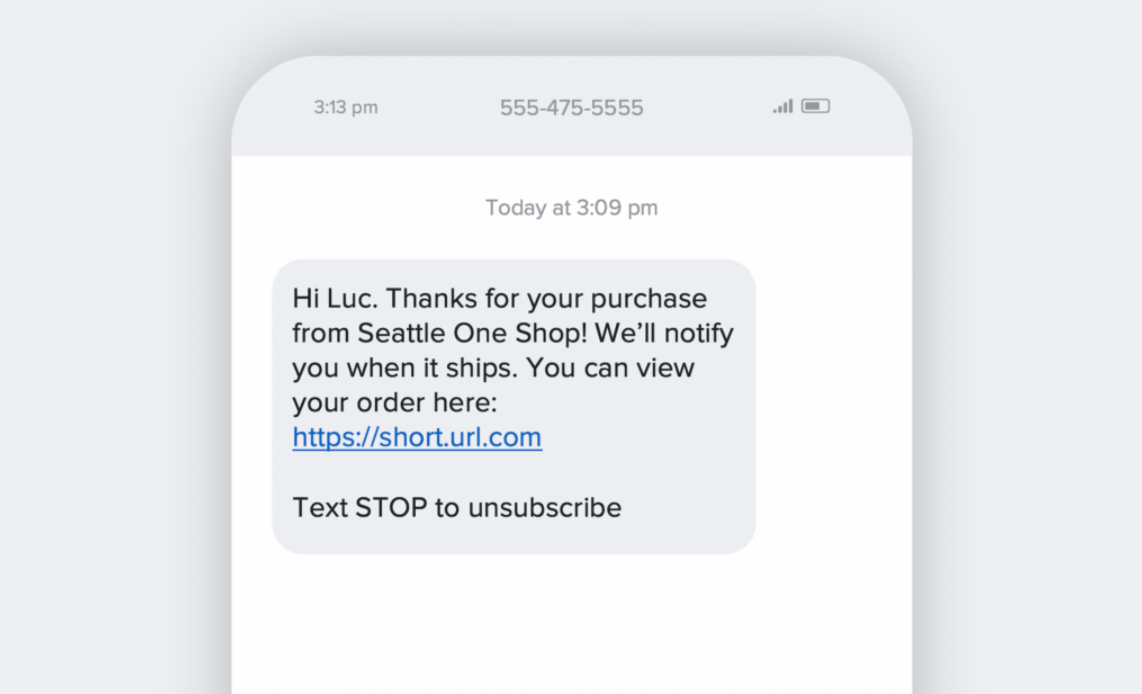
According to the TCPA, subscribers must always have an option to opt-out of receiving your messages. You can choose opt-out words like “STOP,” “END,” or “QUIT” to make this process simple for your audience.
Hopefully, your subscribers won’t choose this option, but at least they know it is there if they need it.
8. Measure performance
As it’s common with all advertising channels, measuring results is integral. If you don’t know what is working and what isn’t, there is no way to improve.
There are some metrics we recommend using to evaluate your SMS marketing campaign performance:
-
Click-through rate. This metric is highly relevant to find out if your campaign is working out. Are recipients clicking on your link? If not, you need to find out why.
-
Delivery receipts. Most SMS marketing platforms let you check how many messages were delivered out of the messages sent. This is necessary because it shows if your contacts are real and accurate. There is no use in having 1000 contacts on your list if half of them are fake. The same applies to larger lists.
-
Cost per conversion. To calculate this metric, divide your total sending costs by the number of conversions achieved. This shows you how much it costs to get one conversion - a metric that lets you calculate your costs and evaluate your campaign success.
-
Opt-out rate. If a lot of recipients are opting out, there’s definitely something wrong with your campaign. Maybe you are messaging them too often, or maybe the offers you’re sending are not enticing enough. Test various strategies to decrease your opt-out rate.
The bottom line
Thousands of companies are realizing the power of SMS marketing. It is being used by successful E-commerce brands, top-selling real estate agents, growing churches, and everyone in between.
Despite its popularity, SMS marketing continues to be one of the most underutilized channels. This presents huge upsides for businesses who are willing to try it. There has never been a better time to get started than now.
Thanks for reading until the end of this guide! If you have any questions or concerns about SMS marketing, please contact us for more information. Have a nice day!
New Posts

How To Set Up Google Analytics 4 For Your BigCommerce Store






